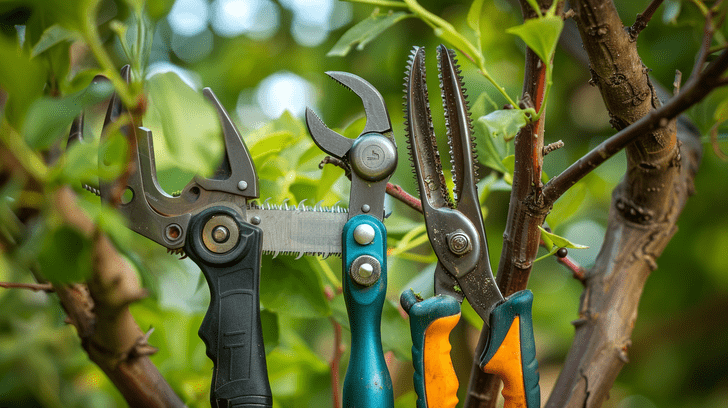How To Prune a Lemon Tree – Tips and Techniques
Pruning a lemon tree is an essential maintenance task to promote healthy growth, increase fruit production, and maintain its shape.
To prune a lemon tree, start by removing any dead, diseased, or damaged branches to prevent the spread of disease and encourage air circulation.
Next, identify any crossing or rubbing branches and trim them to allow sunlight to reach the fruit-bearing branches. Cut back any leggy growth to encourage bushy growth and a more compact shape.
Thin out the center of the tree to allow air and sunlight to reach the fruiting branches, and remove any water sprouts or suckers that are growing from the base of the tree.
Finally, prune any branches that are growing inwards or downwards to maintain the tree’s natural shape and promote fruiting. Regular pruning will help your lemon tree thrive and produce an abundance of juicy lemons.
Why Pruning is Essential for Lemon Trees
Pruning is essential for lemon trees because it promotes healthy growth, increases fruit production, and prevents the spread of diseases.
When you prune your lemon tree, you’re allowing it to focus energy on producing fruit rather than wasting it on unnecessary growth.
This, in turn, will increase your harvest and make your tree more productive.
Additionally, pruning lemon trees helps maintain air circulation, reducing the risk of fungal diseases that thrive in humid environments.
By pruning your lemon tree regularly, you’ll encourage a strong, balanced structure that’s better equipped to support the weight of fruit.
Proper lemon tree pruning techniques will have your tree thriving in no time.
Understanding the Anatomy of a Lemon Tree
To effectively prune your lemon tree, you must first understand its anatomy. The tree consists of a central leader, scaffold branches, and fruiting branches that grow from the scaffold.
The central leader is the main trunk of the tree, providing structural support. Scaffold branches are the primary limbs that grow from the central leader, forming the framework of the tree. Fruiting branches, which produce lemons, grow from the scaffold branches.
When pruning, it’s crucial to identify these components to make targeted cuts that promote healthy growth and fruit production. By understanding your lemon tree’s anatomy, you’ll be better equipped to prune effectively, encouraging a strong, productive tree.
Step-by-Step Pruning Process
With your lemon tree’s anatomy in mind, you’re ready to start pruning, beginning with the removal of any dead, diseased, or damaged wood.
This step is essential, as it prevents the spread of disease and encourages healthy growth. Use clean, sharp pruning tools to make precise cuts, and remove any branches that are crossing or rubbing against each other.
Next, identify any suckers or water sprouts, which can divert energy from the rest of the tree, and trim them off.
Timing Your Pruning: Seasonal Considerations
As you prepare to prune your lemon tree, considering the timing of this process is essential, since pruning at the wrong time can hinder fruit production or create vulnerabilities to disease and pests.
Pruning your lemon tree during its dormant season (winter) is ideal, as it allows the tree to focus energy on new growth. Avoid pruning during the active growing season (spring-fall), as this can cause stress and reduce fruit production.
Trimming your lemon tree during the summer months can help control its size and promote air circulation, reducing the risk of disease. By pruning at the right time, you’ll encourage healthy growth, maximize fruit production, and keep your lemon tree thriving.
Tools of the Trade: Essential Pruning Equipment
Equipped with the right tools, you’ll be able to tackle pruning tasks efficiently and effectively, making all the difference in the health and productivity of your lemon tree.
A good pair of pruning shears is essential for trimming and pruning branches up to ¾ inch in diameter. For thicker branches, loppers or hand saws are necessary. Make sure your tools are sharp and clean to prevent spreading diseases. A pruning saw is also handy for making precise cuts.
Don’t forget gloves and safety glasses to protect yourself from thorns and debris. With the right equipment, you’ll be able to prune your lemon tree with confidence, promoting healthy growth and maximizing fruit production.
Pruning Young vs. Mature Lemon Trees
Pruning strategies differ considerably depending on the age of your lemon tree, and understanding these distinctions is important for the best tree development and fruit production. When you prune a lemon tree, you need to take into account its age to get the best results.
Here are some key differences to keep in mind:
- Young trees (1-3 years): Focus on shaping the tree’s structure and promoting a strong central leader.
- Mature trees (3+ years): Prioritize fruit production by pruning for air circulation, sunlight penetration, and fruiting branch development.
- Remove any dead, diseased, or damaged branches from your lemon tree, regardless of age.
- Prune during the dormant season to minimize stress and prevent disease.
Aftercare: Nurturing Your Pruned Lemon Tree
What steps can you take to guarantee your newly pruned lemon tree recovers quickly and thrives in the weeks and months ahead?
After pruning, your lemon tree needs proper aftercare to promote healthy growth and fruit production.
This involves maintaining ideal growing conditions, including adequate watering, fertilization, and pest management.
Expert Tips and Tricks for Successful Pruning
By following a few expert guidelines, you can greatly enhance your pruning skills and guarantee a healthy, thriving lemon tree that produces abundant fruit.
To prune a lemon tree effectively, keep the following tips in mind:
- Timing is everything: Prune your lemon tree during its dormant season to minimize stress and promote healthy growth.
- Cut with precision: Use sharp, clean pruning tools to prevent spreading diseases and encourage clean cuts.
- Remove the right branches: Remove any dead, diseased, or damaged branches to prevent the spread of disease and encourage air circulation.
- Don’t over-prune: Prune only what’s necessary to maintain the tree’s shape and promote healthy growth, as over-pruning can stress the tree.
FAQ
When should a lemon tree be pruned?
You should prune your lemon tree during its dormant season, typically in late winter or early spring, to promote healthy growth and fruit production.
This allows you to shape the tree, remove any dead or diseased branches, and encourage new growth.
Pruning at the right time also helps to increase lemons production and improve the overall health of your tree.
Here are some key benefits of pruning your lemon tree at the right time:
- Promotes healthy growth: Pruning helps to remove any dead or diseased branches, allowing your lemon tree to focus its energy on healthy growth.
- Increases fruit production: Pruning helps to encourage new growth, which can lead to more lemons on your tree.
- Improves air circulation: Pruning helps to open up the tree’s canopy, improving air circulation and reducing the risk of disease.
- Maintains shape: Pruning allows you to shape your lemon tree to your desired shape, keeping it looking its best.
Should I cut the thorns off a lemon tree?
When pruning your lemon tree, you may wonder whether to remove its thorns, which can be a concern for gardeners who prefer a more user-friendly tree. The answer is, it’s up to you.
Removing thorns can make your lemon tree more accessible for harvesting and maintenance, but it’s not necessary for the tree’s health.
If you do decide to remove them, use clean, sharp pruning tools to avoid spreading disease. Cut the thorns at the base, making a clean cut just above a node. This will help the tree heal quickly and reduce the risk of infection.
Keep in mind that removing thorns won’t affect your lemon tree’s ability to produce fruit or thrive.
What are the five rules of pruning?
Cutting through the confusion, five fundamental rules of pruning will guide your trimming tasks and yield a thriving lemon tree. To prune your lemon tree effectively, you need to understand these essential principles.
Here are the five rules of pruning:
- Prune with a purpose: Don’t prune randomly; have a reason for every cut you make.
- Cut outside the branch collar: Make clean cuts just outside the raised area where the branch meets the trunk.
- Don’t over-prune: Prune only what’s necessary to maintain the tree’s shape and promote healthy growth.
- Make clean cuts: Use sharp, sterile tools to prevent spreading diseases and encouraging new growth.
How to trim a citrus tree?
Now that you’ve grasped the fundamental principles of pruning, it’s time to apply them to trimming your citrus tree.
To trim a citrus tree, start by removing any dead or diseased branches. This will prevent the spread of disease and encourage healthy growth.
Next, identify any crossing or rubbing branches and remove the weaker of the two. This will improve air circulation and reduce the risk of disease.
When pruning, make clean cuts at a 45-degree angle, and never leave stubs.
For dwarf or compact varieties like Meyer lemons, prune to maintain shape and size.Finally, prune your tree during the dormant season to minimize stress.






![How Much Does Tree Trimming Cost? [+Calculator]](https://abbeytreesurgeons.co.uk/wp-content/uploads/2024/03/how-much-does-tree-trimming-cost.png)
